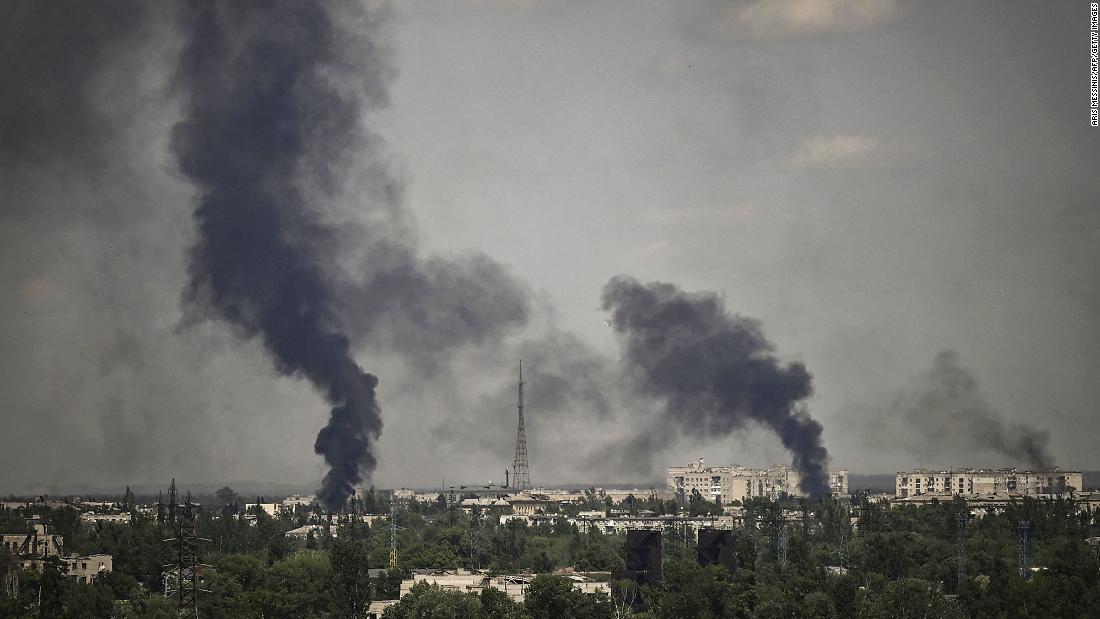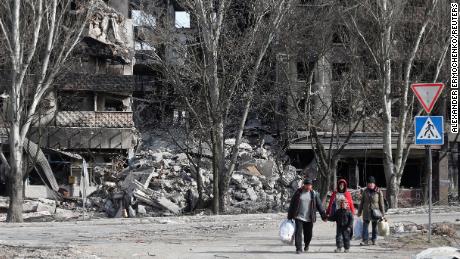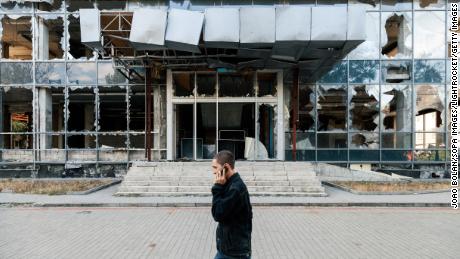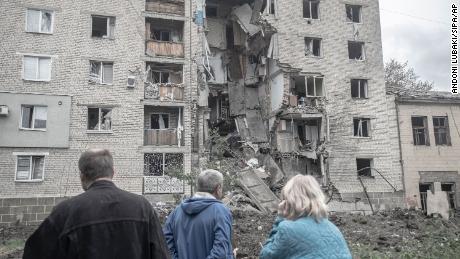
Donbas blankets much of eastern Ukraine, and has been the front line of the country’s conflict with Moscow since 2014.
But now its people, already scarred by eight years of fighting, are enduring an assault even more intense. Russian forces are closing in on the city of Severodonetsk, and are making gradual progress in some parts of the region. Some assaults have been repelled by stubborn Ukrainian counteroffensives.
Failures to take Kyiv and central Ukrainian regions in the invasion’s early months meant Donbas became the centerpiece of Russian President Vladimir Putin’s military ambition.
A Russian victory in the region would appall the West but could salvage Putin’s war aims, while a defeat could cement his invasion as a historic failure. Either way, it is almost certain to devastate yet more of the Donbas region, a historically and culturally significant place whose proximity to Russia has dictated much of its turbulent existence.
Those who have lived in and studied the region describe it as an independent and gritty center of industry that has remained suspicious of outside forces for decades.
But the waves of conflict there since 2014 have reshaped and wounded its cities, and it is along its line of contact that both the Ukrainian and Russian military are most dug in — making for a familiar but unpredictable new phase of war.
‘Fiercely independent’
Chimneys, factories and coal fields have dotted the landscape of Donbas for decades, and since its two major cities were founded — Donetsk by a Welsh ironmaster in 1869, and Luhansk seven decades earlier by a Scottish industrialist — industry has been the lifeblood of the region.
The name Donbas is itself a portmanteau of the Donets Coal Basin, and throughout most of the 20th century it served an outsized role as the industrial heartland of the Soviet Union, pumping out coal in vast quantities.
“The Soviet Union intensively developed the Donbas as an industrial center,” said Markian Dobczansky, an associate at Harvard University’s Ukrainian Research Institute. “It was a place that set the tempo of Soviet industrialization.”
It was a place, too, of “extremely high-stakes industrial production, and repression,” Dobczansky adds. “Terror was present under Soviet rule. Repression happened all over the Soviet Union, but it happened intensely in the Donbas.” Suspicion, arrests and show trials were rife.
A rise in steel and metal manufacturing, the creation of a railroad and the development of a shipping industry in the port city of Mariupol diversified Donbas beyond its coal mining roots.
But in the three decades since the fall of the Soviet Union, the region’s economic might has shriveled. “In the 1990s, the Donbas saw the floor drop out economically,” Rory Finnin, associate professor of Ukrainian studies at the University of Cambridge, told CNN.
A decline in living standards and rampant poverty plagued the region during its initial transition from communism, Finnin said, and Donbas is now often likened to the Rust Belt regions of the United States, where once-thriving heartland locations have struggled to adapt. But an upturn in fortunes followed the turn of the century; Donbas remains Ukraine’s industrial epicenter, complimenting the agricultural production of the rest of the country.
While prosperity in the region has wavered, one steadfast characteristic of its inhabitants has not. The people of Donbas have and remain “fiercely independent,” Finnin said. “It marches to the beat of its own drum.”
The region’s long-standing industrial pull has attracted people from across Eastern Europe over the past century, and it has had strong social and economic ties to neighboring Russia as well as to the rest of Ukraine. Unlike much of central and western Ukraine, which had historically changed hands between various European empires, Donbas spent most of the past millennium under the control of Russia.
In the country’s only post-Soviet census in 2001, just over a half of the population of Donbas was made up of ethnic Ukrainians and a third of ethnic Russians. Russian is by some distance the most widely spoken language in Donbas, unlike in western Ukraine. But the country as a whole has a tradition of multilingualism and the connection between language and national identity is tenuous there, experts say.
The cities of Donbas lie “far away from the metropolitan centers, (and) far away from the big cities” in central and western Ukraine, said Dobczansky. “People could flee to the Donbas and get lost.” Western-influenced, pro-European politics has typically not been embraced in Donbas as it has in the west of Ukraine.
That sense of disconnect from the capital Kyiv and other metropolitan centers has given rise to a vast collection of local movements, and was the backdrop upon which pro-Russian separatists attempted to seize control following Moscow’s annexation of Crimea.
But Finnin and others warn “it’s important not to fall to notions that the Donbas is pro-Russian or anti-Ukrainian,” a concept that has been stirred up relentlessly by the Kremlin since 2014 but is roundly debunked by experts.
In an exclusive CNN poll conducted by Savanta/ComRes shortly before Russia’s invasion began, people in the easternmost region of Ukraine, which includes Donbas, mostly rejected the idea that Ukrainians and Russians are “one people,” and comprehensively disagreed that the two states should become one country.
Fewer than one in five people there felt that way, compared to about a third of Russians who did, demonstrating the lack of desire to change national allegiance despite the region’s longstanding cultural connections with Russia.
“(Pro-Russian) separatism prior to 2014 was a distinctly minority position,” and no organized movement existed, Dobczansky said. Opinion polls — and the region’s own vote for independence in Ukraine’s 1991 referendum — affirmed Donbas’ desire to leave Soviet-era allegiances behind.
“People would have a very strong sense of being a coal miner, or a metal worker, or being in the proletariat,” he added. “People (also) had a sense of being a part of the Ukrainian republic, but the idea was that the Donbas transcended national identities.”
What Donbas means to Putin
Despite its move into independence along with the rest of Ukraine in 1991, Donbas has maintained a place in the psyche of Russian leadership.
Cities like Luhansk and Donetsk are historically “places that (Russians) could see a certain version of themselves,” Finnin said.
And that historical image could still persist inside Putin’s own worldview, experts suggest.
But such a project could not be attempted without an effort to recapture Donbas, given its emotional resonance as the Russian empire’s industrial backbone. “It’s symbolically very important; the Donbas supplied the entire Soviet Union with raw materials,” Dobczansky said.
It is in that context that Putin has refocused his stuttering invasion on the region where his conflict with Ukraine began eight years ago.
“There’s every possibility that Putin will move now to effectively bisect Ukraine; that will give him enough to be able to declare a victory domestically, and allay his critics that this has been a botched invasion,” said Samir Puri, a senior fellow in urban security and hybrid warfare at the International Institute for Strategic Studies (IISS), who worked as a ceasefire observer in Donbas between 2014 and 2015.
“Taking the Donbas (would be) a consolation prize, because Kyiv is now out of Russia’s military grasp, but it’s a good consolation prize,” Puri said.
Eight years of conflict
Putin’s annexation of Crimea and the occupation of parts of Donbas by Russian-backed rebels in 2014 brought to a crashing halt a period of increasing prosperity in the region.
War broke out in 2014 after Russian-backed rebels seized government buildings in towns and cities across eastern Ukraine. Intense fighting left portions of Luhansk and Donetsk in the hands of Russian-backed separatists.
But on the ground, living amid conflict became a way of life. “Eastern Ukraine residents were living in a twilight zone — they were in the front line of a geopolitical despite, and there was a sense of powerlessness,” said Puri, who spent time on each side of the line of contact while observing the ceasefire.
More than 14,000 people have died in the conflict in Donbas since 2014, including 3,000 civilians caught up in the conflict. Ukraine says that since 2014, almost 1.5 million people have been forced to flee their homes, with over half of the registered internally displaced persons staying in the areas of Donbas that remained under Ukrainian control and about 160,000 resettling in the wider Kyiv region.
Russia has meanwhile aggressively attempted to stir up separatist feeling in the region, which it has then pointed to as a justification for invading. Russian passports were offered to residents from 2019, and Kremlin messaging both in Russia and in separatist-held parts of Donbas has heavily played up notions of ethnic Russians being targeted.
“In propaganda since 2014, the Donbas has become a sacrificial lamb in Russian narratives,” Dobczansky said.
“It’s the place where the Russians have cultivated a cult of victimhood. They’ve managed to turn their own fomenting of a war into a narrative of victimhood at the hands of Ukrainian nationalists,” he added. “They hammer this point home.”
That pretext ultimately led to Putin, two days before he launched his full-scale invasion of Ukraine, declaring the Donetsk and Luhansk regions independent in an opening salvo to his war on the country.
A new Russian assault
Whether the raging battle for Donbas will be the final chapter of Russia’s war, or merely its current phase, remains to be seen. But by zeroing in on the region, Putin has brought his assault on Ukraine full circle.
The so-called “liberation” of Ukraine’s Donbas region was described as an “absolute priority” for Russia by its foreign minister Sergei Lavrov, in an interview with French broadcaster TFI in late May.
“The Donbas was the frontline for eight years, so the military positions on both sides are extraordinarily well-fortified,” Dobczansky said shortly before Russia’s invasion refocusing on the territory.
The secessionist conflict in Donbas had been costly but stagnant since the initial surges of pro-Russian forces in 2014; the lines of the conflict barely moved in several years, with trenches running along the point of contact from the southern coast to the Ukrainian-Russian border north of Luhansk.
But Russia has made a number of advancements into parts of the Donbas in the weeks since the battle there began.
Ukrainian President Volodymyr Zelensky has said the situation in the region is becoming increasingly difficult due to a ramp-up in Russian manpower in recent days. “That’s why we have to increase our defense, increase our resistance, and Donbas will be Ukrainian again. Even if Russia will bring all suffering and ruination to Donbas, we will rebuild every town, every community. There’s no real alternative,” Zelensky stressed in a video message last week.
Part of the city of Severodonetsk in eastern Ukraine is “already controlled by the Russian army” and Russian troops are “gradually moving towards downtown Severodonetsk,” Serhiy Hayday, head of Luhansk region military administration said on Tuesday.
Ukraine’s military has said Russia’s current focus is seizing full control of the city, which lies close to the Donetsk-Luhansk boundary. Zelensky has said that 90% of the housing in Severodonetsk had been damaged.
Russia has continued to intermittently strike cities in northern Ukraine; in recent days, Hirsk and Hrinivka in Chernihiv and Bachivsk and Seredyna-Buda in Sumy have suffered shelling. Analysts say Russian attacks on these areas are designed to prevent Ukrainian forces from being redeployed to the main fronts in Donbas.
While Russia is making slow but gradual progress in parts of Donbas, some Ukrainian counter-offensives have seen success. Ukrainian forces have intimate knowledge of the towns and cities they have been defending for nearly a decade. Ukraine’s top general, Valery Zaluzhny, and much of the army’s top guard have on-the-ground experience fighting in the region after 2014.
Zelensky has called for more Western military aid and repeatedly warned in recent weeks of the devastation that Donbas has endured since the new phase of the war began.
“The current offensive of the occupiers in Donbas can make the region uninhabited” Zelensky said last week. “They want to burn Popasna, Bakhmut, Lyman, Lysychansk and Severodonetsk to ashes. Like Volnovakha, like Mariupol.”


